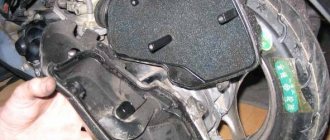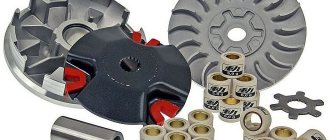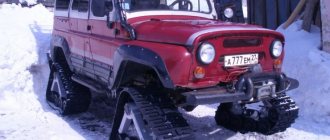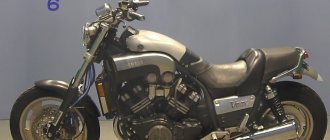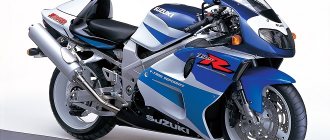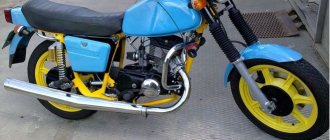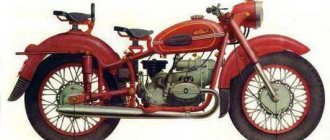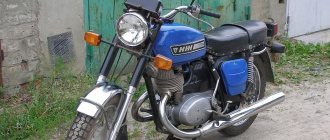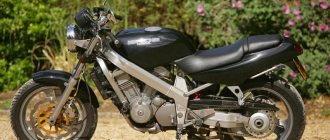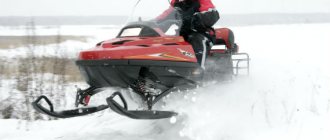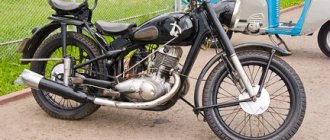The car suspension is one of the main components of the chassis system, due to which the car moves. One such example is MacPherson suspension, which can sometimes be found on cars with front-wheel drive. This is one of the most common types of independent suspension, and is also not very demanding in terms of spare parts and breakdowns. We can also say that McPherson is a developed type of double wishbone suspension, in which engineers installed a shock absorber strut instead of an upper wishbone.
Due to its compact structure and small number of parts, the MacPherson strut suspension allows the engine and transmission to be positioned transversely, and the torque is usually transmitted to the front axle of the vehicle. Another advantage of McPherson is its large stroke, which allows it to prevent breakdowns. Let's take a closer look at the suspension design, characteristics and capabilities in pros and cons.
History of creation
1948 Ford Vedette
This suspension was developed based on the double wishbone suspension used in the 1940s.
Ford engineer Earl McPherson developed and put his invention into mass production. A solution that simplified the design of the suspension with two wishbones was the use of a load-bearing shock absorber strut. A characteristic feature was the presence of a spring in its upper part. When assembled, the structure was a single whole. This eliminated the need to use an upper lever. The first production car with this front suspension design was the 1948 Ford Vedette. Later, modified versions began to be used on other cars of the concern. In the 70s, McPherson's idea was picked up by other automakers. The type of pendant was named after its creator.
What's special?
The peculiarity of the MacPherson suspension is that it is independent for each wheel. That is, the suspension is installed separately on each wheel. In this type of design, instead of two wishbones, one is used, and a shock-absorbing strut is used instead of the second wishbone. In most cases, the rack is assembled with a spring. The entire structure is secured using a rotary joint to the car fender.
The stand is very rarely installed straight. Very often in cars you can observe its location at a certain angle. This set angle has a great influence on the driving characteristics of the car. This suspension can be used for both front and rear wheels.
Suspension device
The MacPherson suspension has become widespread thanks to a very simple device with a small number of components.
Its design includes:
- Body brackets or subframe;
- Lower arm;
- Shock absorber strut;
- Upper support;
- Elements that provide movable connections (rubber elements, ball joints).
These are components of only one wheel. On one axle, two sets of the listed components are used for its two wheels. But there is another component that connects the suspension of the left and right wheels - a stabilizer bar, which at its ends is attached to the struts or levers, and in the central part to the subframe or body.
MacPherson suspension elements
The MacPherson suspension design is very simple. In the lower part, the wheel hub is attached by a movable connection to the body by means of a transverse lower arm. A vertically located shock-absorbing strut is also attached to the hub (although not strictly vertically, but at a certain angle). In the upper part, this rack rests against the body and is attached to it by means of a support. That's the whole design of this independent suspension.
Steering knuckle with hub
Now a little about each component of the suspension. For fastening to the body, brackets are provided in the lower part, which are ordinary eyes, to which transverse arms are attached by means of a bolt connection. But in order to ensure reduced transmission of vibration to the body, the lever is fastened through rubber-metal spacers - silent blocks. These brackets can be made both on the body itself and on a subframe - a tubular structure attached to the load-bearing part.
The simplest version of this suspension uses only one lower wishbone, which is attached at one end through a silent block to the body, and at the other end to the hub via a ball joint. Additionally, a stabilizer is attached to this lever, also through a silent block. But this design does not provide adequate rigidity with respect to the longitudinal displacement of the wheel.
Therefore, more modern MacPherson suspensions use either two wishbones installed at a certain angle relative to each other, or one, but A-shaped. This solution somewhat increases the number of attachment points, and therefore the places where vibration can occur, but it ensures proper fixation of the wheel from longitudinal displacement. In such designs, if the stabilizer is attached to the lever, it is not directly, but through a special rack. But many automakers fix the ends of the stabilizer to the strut body through rods.
The shock absorber strut is the main element of the MacPherson suspension, since its task is to dampen oscillatory movements and reduce their transmission to the body as much as possible. It consists of a housing, through which it is attached to the hub, a spring and a shock absorber. The classic design is a strut, in which the shock absorber and housing are located inside the spring, although there are also designs with an external spring.
MacPherson gas-oil strut device
In the upper part, the rack is secured by means of a special support, against which a spring rests. Often, the support design uses a bearing, which allows the rack to rotate around its axis. What achieves another positive property of this type of suspension is the ability to use it as a steering knuckle.
Distinctive characteristics
If we compare McPherson's development with the previous version of the automobile suspension, the main difference here is that the ball joint was moved to the upper extreme point of the shock absorber strut.
At the same time, the hinge changed, and the support became a radial-type ball bearing. From now on, the entire load falls on the top of the rack. Previously, stamped mud flaps made of thin metal were used in the engine compartment. The main unit was attached to it. But with the advent of the MacPherson suspension, such a mudguard could no longer fulfill its tasks, so they had to strengthen it several times. Having gone through all the improvements, the new version of the car suspension received a simplified design, but fully complied with all current safety requirements. The main peak of popularity occurred in the 70s of the last century. From that moment on, the active use of the development of engineer Earl McPherson began, which has not declined to this day. This is due to the appearance of a telescopic shock absorber strut, the service life of which has increased significantly. It was the new shock absorber that made the MacPherson suspension a real bestseller of its time, and also allowed the device to remain relevant to this day. New developments in the automotive industry have made Earl's suspension technologically advanced, but at the same time very cheap to manufacture. Therefore, MacPherson is actively used on budget and middle class cars.
Pros and cons of MacPherson suspension
As with every device, MacPherson suspension has its pros and cons in comparison with other subtypes of independent suspensions. First, let's look at the main advantages that engineers and specialists most often highlight, since this suspension is widespread on modern cars:
- Reliability and simplicity of the design itself provide a very long service life;
- Versatility, MacPherson suspension works perfectly on both the front and rear axles of the car;
- Relatively low production cost. A small number of components makes this suspension the most accessible and inexpensive;
- Small sizes. Due to the small number of parts, it can be used even on the most compact cars;
- Suspension travel with a large margin. Due to this reserve, the likelihood of a breakdown of the suspension or transfer of impact energy to the car body is reduced;
- Reduced load on moving suspension elements. The main force is taken by the stand, but ball joints and silent blocks ensure the mobility of the mechanisms, due to which they have received a good reserve of service life.
Despite these advantages of the MacPherson suspension, there are still disadvantages that have played an important role in their widespread use on all cars:
- Difficulty in maintaining the shock absorber strut. To replace one part or carry out maintenance on other components, it is necessary to completely remove the entire structure, but for disassembly you will need a special tool, since it is not so easy to compress and release the spring;
- Constant load on the rack. It is this factor that affects the service life of the suspension; as a rule, it is proportional. The greater the load, the shorter the service life;
- Wheel alignment and kinematics. In the case of a long stroke of the shock absorber strut, the toe-in angles change over a wide range. As a result, the vehicle's stability and controllability decrease and tire wear increases;
- Strengthening the attachment point on the body of the upper part of the shock absorber strut. We can say that this part of the body can withstand overloads the most; if not strengthened, cracks or corrosion may appear;
- Increased operating noise. Due to noisy mechanisms, MacPherson suspension is not used on premium cars; most often, preference is given to the multi-link version. This type of suspension ensures quiet and smooth movement of the car body.
Considering the pros and cons of the MacPherson suspension, they still decided to use it on many production cars as one of the options for independent suspension. Cheap, simple and reliable, which makes it popular. In addition to the standard set, there are also modified options. In this case, instead of a standard shock absorber, the manufacturer installs a hydropneumatic shock absorber.
Due to this modification, you can change the stiffness of the suspension and install an additional ball joint on top. In turn, this affects the improvement of handling when driving over uneven roads.
Application
Despite the presence of a small number of disadvantages, most popular models use this version of independent suspension. This is facilitated by its simplicity, reliability and low cost for mass production.
In addition to the standard set of elements, modernized variations are used in the designs. In such options, it is customary to replace the standard shock absorber with a hydropneumatic analogue.
What machines have this type of design? For example, it can be found on the Mercedes-Benz W124, many models of BMW, Skoda (Octavia), Mitsubishi (Lancer), Kia (Soul), Honda (Creta), Audi 80 and in the domestic auto industry VAZ 2109.
How it works
The MacPherson suspension works like this: when hitting a bump, the wheel moves vertically relative to the body and this is ensured by a strut (due to spring compression) and a lever attached by movable joints to the hub and the load-bearing part.
The spring perceives the force, but it is not able to quickly extinguish it, and here the shock absorber comes into play, which absorbs all the energy.
When hitting a bump, a force also arises that tries to move the wheel itself in the longitudinal direction. Such a negative effect is “fighted” by two levers installed at an angle or one A-shaped one, in which two peaks are attached to the body and only one to the hub.
After overcoming the unevenness, the spring takes its original position, due to which the wheel, relative to the body, is aligned.
When overcoming bumps, both wheels move independently of each other. But at the same time, the suspension is not able to completely absorb all the forces and some of them are still transferred to the body. In this case, there is a possibility of swinging of the load-bearing part if both wheels move on uneven ground.
To prevent this from happening, an anti-roll bar is used, connecting two independent suspensions of the same axle. It is a regular torsion bar and, due to the emergence of forces that counteract torsion, it is able to dampen the oscillatory movements of the body.
Principle of operation
If we consider the operation of this device in a more generalized form, it looks like this: a car wheel driving over road irregularities smoothly tends upward, then sequentially moves back. You should not ignore the load that appears at this moment, which is transferred to the compressing or straightening spring. At the same time, a telescopic stand works, which either lengthens or, conversely, shortens.
Some component of the load is transferred to the body, due to which the spring in the car gradually straightens, acquiring its original shape, as a result of which the rack lengthens. The resulting vibrations are dampened by the internal shock absorber, due to which the movement of the car body up and down relative to the earth’s surface practically disappears. When turning, the strut, working in conjunction with a fist and a wheel on the hub, changes movement and turns, which helps change the direction of the car.
MacPherson type suspension is most often installed in cars with a driven front axle, where the engine is located perpendicular to the travel. On the one hand, this design is in many ways superior to the standard two-lever layout system, and on the other hand, it is in many ways inferior to it.
Signs and malfunctions of MacPherson suspension
The first and very noticeable malfunction is the rocking of the car body
. The main sign that the shock absorber struts are exhausting their service life and are becoming unusable. The result is loss of comfort, deterioration in vehicle handling, as well as accelerated wear of related suspension parts.
Cars equipped with ABS and ESP
, in the event of a breakdown, the suspensions begin to operate and signal more often. As soon as your “iron horse” begins to nod or sway, you should not put it off until later. The result of such breakdowns is a proportional increase in braking distance; the greater the breakdown, the slower the car will stop. Accordingly, the safety of the car is lost.
Loss of directional stability
Another reason why you should pay attention to your car's suspension. The failure or weakening of one of the shock absorbers leads to a decrease in the vehicle's support on all 4 wheels. Thus, when entering a turn, the car simply skids; the very slipping of any axle indicates a possible breakdown.
At least once in their life, every driver has felt a car nodding or throwing up its rear.
. This usually leads to poor health, decreased attention, or much more dramatic consequences of such a breakdown. This is another sign of failure of the car’s shock absorbers; the very rocking and incorrect distribution of the car’s weight is felt during sudden acceleration or braking. There is no way to sit comfortably in such a car, and besides, all this harms the body structure.
Reducing ground clearance
it is also a sign of failure of one of the suspension parts, unless of course you are a supporter of “lowered” cars, and the car’s suspension has not been modified. There can be several reasons for such a breakdown, tired metal, corrosion of one of the parts. Most often, the springs can sag (they shorten the compression stroke), due to which the entire force of the impact is transferred to the body and interior of the car, and the connections and joints on the body and interior expand.
Uneven tire wear and excessive hardness
, it is with these indicators that most problems with the suspension begin. You can see tire wear with the naked eye, and the stiffness will be noticeable when driving on uneven roads. For MacPherson suspension, this is a very common phenomenon, due to a floating wheel angle (impaired wheel alignment) or sagging of the shock absorber strut as a whole.
Flaws
The disadvantages are as follows:
- weak kinematic parameters, the tendency of the front wheel to change the angle of inclination in the vertical plane, sometimes within significant limits;
- gradual cracking of the mudguard socket in the seat of the support bearing of the shock absorber strut and, as a result, the appearance of corrosion;
- when operating on roads with poor-quality surfaces, the working life of the MacPherson suspension is sharply reduced;
- repair of the device, both current and major, is expensive, since it is associated with a very complex system for assembling and disassembling components;
- lack of compensation for longitudinal rolls of the car, rollbacks are practically absent;
- due to its structural mechanical weakness, MacPherson suspension is never used in sports models and racing cars;
- frame cars cannot carry MacPherson-type suspension, since there is no way to combine its upper brackets with the base - it is too high;
- the suspension is not compatible with the hydropneumatic chassis of most models of classes C and E;
- the rear suspension cannot withstand longitudinal stresses, especially in emergency braking mode.
Suspension components
Shock absorber
It is a shock absorber with a coil spring installed on the body. The spring is sandwiched between the lower and upper cups. The upper shock absorber support is fixed to the body in a special niche under the car's wing. The rotation of the wheel is carried out due to the bearing integrated into it. The bottom of the MacPherson strut connects to the hub assembly. The stand is not installed vertically, but at a certain angle to the car wheel in the transverse plane. This angle is called king pin angle or KPI and has a big impact on the vehicle's handling. This parameter is not adjustable and is included in the suspension design during design.
Lower wishbone
A guide element that provides vertical movement of the suspension. It has two attachment points to the body subframe. Less common is the option with one fastening, with the second point being duplicated by a longitudinal (reactive) thrust. Through a ball joint, it secures the wheel hub in its lower part.
Anti-roll bar
An elastic curved metal rod attached to the subframe and both arms. Designed to level the lateral roll of the car. When turning, the side with less inclination supports the opposite one.
Creation
In the year James Macpherson published the poem "The Highlander", and in the year - the book "Fragments of Ancient Poetry Collected in the Highlands of Scotland", published anonymously. Then, in the year, Macpherson was sent by the Edinburgh Bar to the mountains of northern Scotland in search of material about the epic hero Fingal (Finn MacCull), whose deeds were told by his son Ossian. There were reasons for such an expedition: until recently, illiterate Gaelic storytellers were able to repeat ancient legends, which in written form exceeded 80 thousand lines, many times word for word. But, apparently, MacPherson had neither the funds nor the time to delve too deeply into the material. Soon the book was published almost simultaneously in two editions; and less than a year later it was reprinted in London. The publication was a success, and with the money collected from the subscription list, Macpherson made another trip to the Highlands of Scotland to obtain new materials. This is how the poems “Fingal” (1762) appeared, based on the legends of Finn McCull, and “Temora” (Temora, 1763), allegedly created by the legendary Irish hero Ossian in the 3rd century. Macpherson then combined them with the "Passages" into "The Works of Ossian, son of Fingal, translated from the Gaelic by James Macpherson." Ossian's poems gained enormous popularity in Europe and America, but the secret was revealed and Macpherson was accused of literary hoax.
Macpherson's writings provided him with a significant fortune. His “Ossian” poems were, in essence, only a free adaptation of genuine Celtic legends. Nevertheless, the fame of a literary falsifier was brought to Macpherson by his “impudence and pseudo-scholarship,” which was unpleasant to the London elite, through which he tried to defend the scientific integrity of his publications (we should not forget that the genocide of the Highlanders that followed Culloden () was memorable both to supporters of the ruling dynasty and highlanders, and the MacPherson clan was considered one of the most rebellious). The authenticity of the so-called “poems of Ossian” was questioned by Samuel Johnson. After Macpherson's death, his literary hoax became a "generally accepted fact", but modern scholarship is inclined to believe that he did not so much falsify the poems as compile and edit the true tales in the spirit of sentimentalism. Up to 30 fragments included in the "Poems" were found in the so-called "Book of the Dean of Lismore" (en: The Book of the Dean of Lismore, Gaelic Leabhar Deathan Lios Mòir, a manuscript that was compiled in 1512-1526 from what they wrote down ancient Scottish legends brothers James MacGregor (Gaelic: Seumas MacGriogair) and Duncan MacGregor (Gaelic: Donnchadh MacGriogair).
Influence on European literature
Despite the questioned merits of Macpherson's poems and despite his stylization in the spirit of pre-romanticism, the “poems of Ossian” had a huge influence on European and, in particular, Russian literature. Derzhavin, Karamzin, Batyushkov, Dmitriev, Gnedich, Zhukovsky, Baratynsky and many other poets translated them and imitated them. It should be specially noted that the rhymed arrangement of one of the short poems of “Ossian” - “Kolna” was performed by Pushkin in his youth (in Macpherson’s “Kolna-Don”); it ends the second volume of the Poems of Ossian.
The difference between a shock absorber and a shock absorber
Shock absorber is a damping element of the suspension designed to dampen vibrations. The shock absorber strut, in turn, consists of a shock absorber and a spring. Thus, in addition to design features, the rack performs many more functions, namely, it is simultaneously a load-bearing, elastic and damping structural element.
Suspension strut
The difference between a strut and a conventional shock absorber:
- It is a more complex mechanism.
- It has a reinforced structure and a larger rod diameter.
- It is an elastic element that absorbs loads from the road surface.
- Supports the weight of the car.
- The rotary support of the shock absorber is involved in turning the wheels of the car.
- Resists axial and lateral loads.
Development prospects
The above design description gives a general idea of what MacPherson strut suspension is and how it works. One of the disadvantages of this scheme is that the running arm in it always has a positive value, in other words, the turning axis is located on the inside of the point of contact of the wheel with the road. This reduces directional stability and creates significant steering forces.
The problem was solved by the famous German company ZF Lemförder, which proposed introducing a number of additional elements into the classic McPherson suspension. The design was named Revo-Knuckle and was patented in Europe and the Americas. The introduction of two hinges into the circuit made it possible to separate the functions of the guide and the rotating mechanism.
McPherson strut with Revo knuckle
This design significantly reduces friction and disturbance from backlash. In terms of its parameters, this design is close to a design with two levers. The designers managed to make a unit that is installed on the car without altering its body by simply replacing it. As a result, cornering behavior, especially in the presence of ruts, became noticeably more stable and predictable.
Video - MacPherson suspension working on a car:
May be of interest:
Choose a DVR: an indispensable gadget for the driver
Scanner for self-diagnosis of a car
Gifts for car enthusiasts - what to choose?
Some drivers prefer a DVR in the form of a mirror
MacPherson type rear suspension
On vehicles with independent rear suspension, the MacPherson arrangement is also used. However, it was already developed by another designer named Chapman. His name is often used in the title. The principle of operation and device are similar to the front one.
Rear independent MacPherson suspension
Advantages:
- It is lightweight due to less load on the rear of the car.
- Allows for improved overall handling.
- It has the constructive ability to implement wheel rotation. Relevant for a number of cars with steering rear suspension.
Despite the existing shortcomings, suspension based on guide struts is optimal for most middle-class passenger cars. Some of the decisive advantages remain production cost and maintainability.
The problem of realizing opportunities
In 1982, MacPherson suspension began to be used on more expensive cars. These can easily include the Audi 100, Mercedes 124, the current model range from BMW and many other cars. For several years, the decision of automakers was completely justified and logical. But gradually the suspension ceased to correspond to current trends and began to become outdated. Its technical characteristics no longer corresponded to new trends in car development. For newer and more expensive cars, MacPherson was no longer suitable, since it could not provide the required quality of kinematics and a sufficiently smooth ride. And manufacturers of expensive foreign cars did not need to use cheap components.
Although the MacPherson scheme corresponded to its direct functions, they began to gradually abandon it. But manufacturers of cheap cars did not exclude this suspension from their design, since it was ideal in terms of performance and cost. Gradually, the suspension was improved and modernized, but it remained the property of the predominantly budget segment of the automotive industry.
Russian translations
- Russian translations from Ossian have appeared since 1788 (translated by A. I. Dmitriev). Complete translation from a very popular in the 18th century. French translation of Letourneur was made by E.I. Kostrov: Ossian, son of Fingal, bard of the third century: Gaulish (otherwise Ersky, or Irish) poems, part. 1-2, M., 1792; The same, ed. 2nd, hch. 1-2, St. Petersburg, 1818. Later, many people translated excerpts from O., starting with Karamzin, Derzhavin and Ozerov, ending with Pushkin and Zhukovsky.
- Poems of Ossian. Research, translation and notes. E. V. Balobanova, ed. magazine “Pantheon of Literature”, St. Petersburg, 1890; The same, transl. with notes E. Balobanova, St. Petersburg, 1893 (“Russian classroom library”, edition edited by A. N. Chudinov).
- Poems of Ossian. Translation and approx. Yu. D. Levina. Series "Literary Monuments". Publishing house "Science". Leningrad, 1983. In addition - samples of most Russian transcriptions of Ossian's poems.
Biography
Originated from the mountainous region of Badenoch in the north of the country. Graduated from King's College, Aberdeen. Wrote poetry. He worked as a schoolteacher in his home town of Ruthven near Inverness, Scotland. Knew Gaelic. His close clan relative was the prominent Gaelic poet Lachlan Macpherson (Gaelic: Lachlan Mac a'Phearsain; 1723 - ca. 1795)
After the "exposure of the Ossian hoax", Macpherson tried to translate Homer, but failed. He spent two years in America, where he was secretary to the governor of Florida, then returned to London and became a member of parliament. He died at his Bellville estate. The Gaelic poet Duncan Mackay responded to Macpherson's death with a long funeral elegy in the traditional Gaelic genre "cumha". From Scotland, where Macpherson died, his body was brought to London; he is buried in Westminster Abbey, a few steps from his worst enemy, Dr. Johnson.
